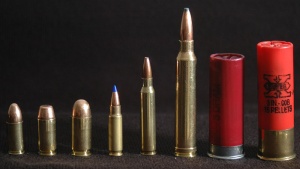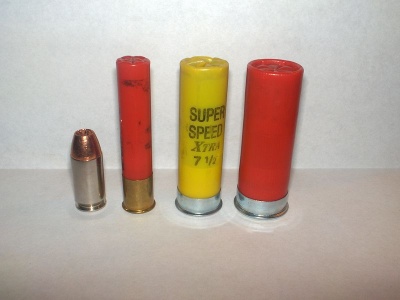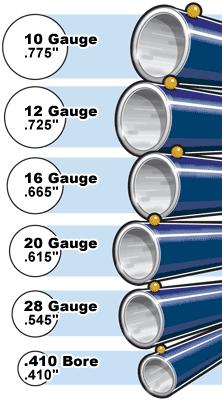Gauge (bore diameter)
The Gauge or bore of a shotgun is a unit of measurement used to express the diameter of the barrel. The gauge or bore of a barrel is equal to the number of solid spheres of lead each having the same diameter as the barrel that would in total weigh a pound.
The term also related to the measurement of black powder cannon, which were also measured by the weight of their round iron shot; a 6 pounder, for example, would fire a 6 pound (2.7 kg) spherical cast iron ball, which gave a bore diameter of about 91 mm (3.6 inches).
Contents |
[edit] Calculating gauge
An n-gauge diameter means that n balls of lead (density 11.352 g/cm³) with that diameter weigh one pound (453.5924 g). Therefore an n-gauge shotgun has a bore diameter (in millimeters) of approximately
[edit] Gauge in use

Since shotguns were not originally intended to fire solid projectiles, but rather a compressible mass of shot, the actual diameter of the bore varies quite a bit. The fact that most shotgun bores are not cylindrical also causes deviations from the ideal bore diameter.
The chamber of the gun is larger, to accommodate the thickness of the shotshell walls, and a "forcing cone" in front of the chamber reduces the diameter down to the bore diameter. The forcing cone can be as short as a fraction of an inch, or as long as 4 inches on some guns. At the muzzle end of the barrel, the choke can constrict the bore even further, so measuring the bore diameter of a shotgun is not a simple process, as it must be done away from either end.
Shotgun bores are commonly "overbored" or "backbored", meaning that most of the bore (from the forcing cone to the choke) is slightly larger than the value given by the formula. This is claimed to reduce felt recoil and improve patterning. The recoil reduction is due to the larger bore producing a slower acceleration of the shot, and the patterning improvements are due to the larger muzzle diameter for the same choke constriction, which results in less shot deformation. A 12 gauge shotgun, nominally 18.5 mm (0.729 inches), can range from a tight 18.3 mm to an extreme overbore of 20.3 mm. Some also claim an increased velocity with the overbored barrels, up to 15 m/s (50 feet per second), which is due to the larger swept area of the overbored barrel. Once only found in expensive custom shotguns, overbored barrels are now becoming common in mass marketed guns. Aftermarket backboring is also commonly done to reduce the weight of the barrel, and move the center of mass backwards for a better balance. Factory overbored barrels generally are made with a larger outside diameter, and will not have this reduction in weight—though the factory barrels will be tougher, since they have a normal barrel wall thickness.
Firing slugs from overbored barrels can result in very inconsistent accuracy, as the slug may be incapable of obturating to fill the oversized bore.
[edit] Sizes in use
Certain sizes are more common than others; 12-gauge is the most common size, with up to 50% of the overall market in the United States. The 20-gauge is popular with shooters who are uncomfortable with the weight and recoil of a 12 gauge gun, and is popular for upland game hunting. The next most popular size is the .410, which is not a gauge, but a caliber. 10, 16 and 28 gauges, while less common, are still readily available. Shotguns larger than 10-gauge are rarely manufactured nowadays; punt guns and special purpose guns like the 4 gauge KS-23 do exist, but are rarely encountered. Also seen in limited numbers are smoothbore firearms in calibers smaller than .410, such as .22 Long Rifle, .22 WMR, and 9mm rimfire, designed for short range pest control.[1][2][edit] Gauge and shot type
The 10 gauge was headed into obsolescence until steel and other non-toxic shot started to be required for waterfowl hunting, as the larger case could hold the much larger sizes of shot needed to get the low density steel shot to the ranges needed for waterfowl hunting; this same move effectively shut out the 20 and smaller gauges as well. However, the advent of the 3 1/2" (89 mm) 12 gauge shell, with its higher SAAMI pressure rating, meets or exceeds the performance of the 10 gauge loadings. Newer non-toxic shots, such as bismuth and tungsten-nickel-iron alloys, and even tungsten-polymer blends, regain much or all of the performance loss, but at the cost of a much higher cost than steel or lead shot.[3]
[edit] Conversion guide
A table showing the various shotgun gauge sizes with weights. The bores marked * are found in punt guns and rare weapons only. The .410 bore is an exception; it is an actual bore size, not a gauge. If the .410 were measured traditionally, it would be 67½ gauge.
| Gauge (Bore) |
Caliber | Weight of lead ball | |||
|---|---|---|---|---|---|
| (mm) | (in) | (g) | (oz) | (gr) | |
| 1½* | 37.05 | 1.459 | 302.39 | 10.667 | 4667 |
| 2* | 33.67 | 1.325 | 226.80 | 8.000 | 3500 |
| 3* | 29.41 | 1.158 | 151.20 | 5.333 | 4667 |
| 4 | 26.72 | 1.052 | 113.40 | 4.000 | 1750 |
| 23.75 to 24.25 (Euro) | .935 to .955 (Euro) | ||||
| 8 | 21.21 | .835 | 56.70 | 2.000 | 875 |
| 10 | 19.69 | .775 | 45.36 | 1.600 | 700 |
| 12 | 18.53 | .729 | 37.80 | 1.333 | 583 |
| 13 | 18.04 | .710 | 34.89 | 1.231 | 538 |
| 14 | 17.60 | .693 | 32.40 | 1.143 | 500 |
| 16 | 16.83 | .663 | 28.35 | 1.000 | 438 |
| 20 | 15.63 | .615 | 22.68 | 0.800 | 350 |
| 24 | 14.70 | .579 | 18.90 | 0.667 | 292 |
| 28 | 13.97 | .550 | 16.20 | 0.571 | 250 |
| 32 | 13.36 | .526 | 14.17 | 0.500 | 219 |
| 67½ | 10.41 | .410 | 6.71 | 0.237 | 104 |
[edit] See also
[edit] References
- ↑ Clair Rees (March, 2000). "Marlin's "Garden Gun" - Model 25MG". Guns Magazine.
- ↑ Frank C. Barnes, ed. Stan Skinner. Cartridges of the World, 10th Ed.. Krause Publications. ISBN 0-87349-605-1.
- ↑ Why The 10 Gauge Shotgun is Obsolete, Randy Wakeman


